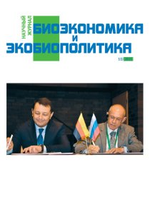The New University of Applied Sciences Hamm-Lippstadt: Thriving for Excellence in Teaching And Science
Автор: Egon Amann
Рубрика: Тезисы
Опубликовано в Биоэкономика и экобиополитика №1 (1) декабрь 2015 г.
Дата публикации: 15.01.2016
Статья просмотрена: 12 раз
Библиографическое описание:
Egon, Amann. The New University of Applied Sciences Hamm-Lippstadt: Thriving for Excellence in Teaching And Science / Amann Egon. — Текст : непосредственный // Биоэкономика и экобиополитика. — 2015. — № 1 (1). — URL: https://moluch.ru/th/7/archive/20/658/ (дата обращения: 25.04.2025).
The University of Applied Sciences was founded in 2009. Today, it comprises 4.500 students studying in fourteen different Bachelor and five Master degree programs at two locations - the cities of Hamm and Lippstadt. Currently, the University is staffed with 77 Professors, 65 Research Associates and 94 administrative and technical employees. The University is still in its planned growth phase, aiming for employing 120 Professors and 120 additional staff in its final state in a few years.
The University is headed by its President Prof. Klaus Zeppenfeld and its Vice-President Karl-Heinz Sandknoop. The University currently has four departments (two in Hamm and two in Lippstadt) and comprises brand new Buildings and state-of-the art laboratories.
Bachelor and Master Degree programs include: “Energy Engineering and Resource Optimization, Biomedical Engineering, Technical Management and Marketing, Intelligent Systems Design, Sports and Health Care Engineering, Product and Asset Management, Applied Biomedical Engineering, Mechatronics, Industrial Engineering with Business Studies, Computational Visualistics und Design, Material Design –
Bionics and Photonics, Social Media and Communication Informatics, and Business and Systems Engineering. In 2015 the following Bachelor and Master Degree programs were newly introduced: Environmental Monitoring and Forensic Chemistry, Intercultural Industrial and Organizational Psychology, Biomedical Management and Marketing, Business Administration, Industrial Engineering and Design, and Technical Entrepreneurship and Innovation.
This broad orientation of study programs is supported by central functions like the Center for Knowledge Management, the Center for Teaching Management and a (planned) Center for Research Management. Additionally, essential administrative support is provided by the functions of Academic and Student Affairs, Organization and Service, and Finances, Research and Human Resources.
Whereas the Universities’ initial years were characterized by focusing on excellence in teaching, now new efforts are made to thrive in science and technology. These efforts include establishing links to basic and industrial research institutions and companies as well as directing independent and strong sciences programs within the University. Examples of such research programs relating to Bioindustry, Bioresources and Biotechnology include the MOST- (Model-based process control of biogas facilities) Project directed by Prof. Dr. Dieter Bryniok, and the LEUKAEMIA- (Microchip for differential diagnosis of leukaemia) Project directed by Prof. Dr. Lara Tickenbrock.
The infrastructure to initiating additional, innovate Biotech programs is established.







